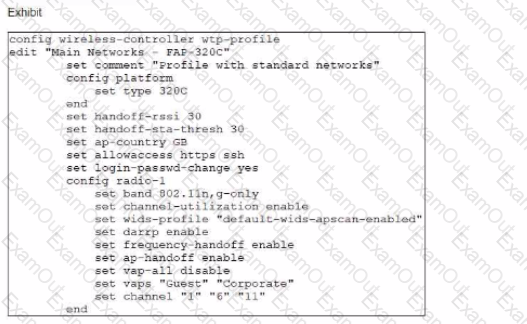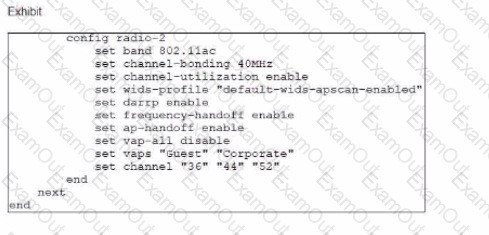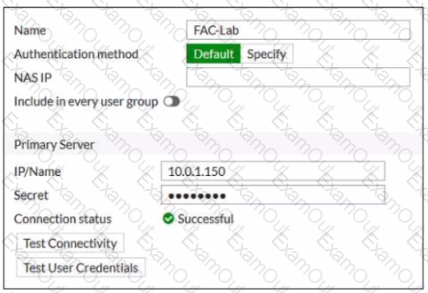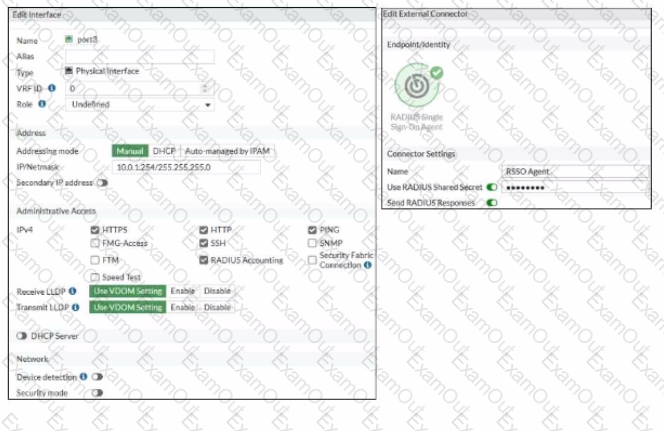Which two statements about MAC address quarantine by redirect mode are true? (Choose two)
Refer to the exhibit.

Examine the network diagram and packet capture shown in the exhibit
The packet capture was taken between FortiGate and FortiAuthenticator and shows a RADIUS Access-Request packet sent by FortiSwitch to FortiAuthenticator through FortiGate
Why does the User-Name attribute in the RADIUS Access-Request packet contain the client MAC address?
Refer to the exhibits.

Examine the LDAP server configuration and output shown in the exhibits.

Note that the Distinguished Name and Username settings on the LDAP server configuration have been expanded to display their full contents.
An LDAP user named student cannot authenticate. While testing the student account, the administrator gets the CLI output shown in the exhibit.
According to the output, which FortiGate LDAP server settings must the administrator check?
An administrator has configured an SSID in bridge mode for corporate employees All APs are online and provisioned using default AP profiles Employees are unable to locate the SSID to conned
Which two configurations can the administrator verify? (Choose two)
Refer to the exhibits.

In the WTP profile configuration shown in the exhibit, the AP profile is assigned to two FAP-320 APs that are installed in an open plan office.

The first AP has 32 clients associated with the 5 GHz radios and 22 clients associated with the 2.4 GHz radio. The second AP has 12 clients associated with the 5 GHz radios and 20 clients associated with the 2.4 GHz radio.
A dual-band-capable client enters the office near the first AP and the first AP measures the new client at -33 dBm signal strength. The second AP measures the new client at 2 -43 dBm signal strength.
If the new client attempts to connect to the corporate wireless network, with which AP radio will the client be associated?
An administrator is deploying AP's that are connecting over an IPsec network. All APs have been configured to connect to FortiGate manually. FortiGate can discover the APs and authorize them. However, FortiGate is unable to establish CAPWAP tunnels to manage the APs.
Which configuration setting can the administrator perform to resolve the problem?
Refer to the exhibit.

Examine the RADIUS server configuration shown in the exhibit
An administrator has configured a RADIUS server on FortiGate that points to FortiAuthenticator FortiAuthenticator is acting as an authentication proxy and is configured to relay all authentication requests to a remote Windows AD server using LDAP
While testing the configuration the administrator noticed that the diagnose test authserver command worked with PAP, however authentication requests failed when using MSCHAP2
Which two solutions can the administrator implement to get MSCHAP2 authentication to work'' (Choose two.)
Which three protocols are used for controlling FortiSwitch devices on FortiGate? (Choose three.)
Refer to the exhibit.
Examine the FortiGate RSSO configuration shown in the exhibit.

FortiGate is configured to receive RADIUS accounting messages on port3 to authenticate RSSO users. The incoming RADIUS accounting messages contain the username and group membership information in the User-Name and Class RADIUS attributes, respectively.
Which three settings must you configure onFortiGate to successfully authenticate RSSO users and matchthem to the existing RSSO user groups? (Choose three)
To troubleshoot configuration push issues on a managed FortiSwitch, which FortiGate process should an administrator enable debug for?

